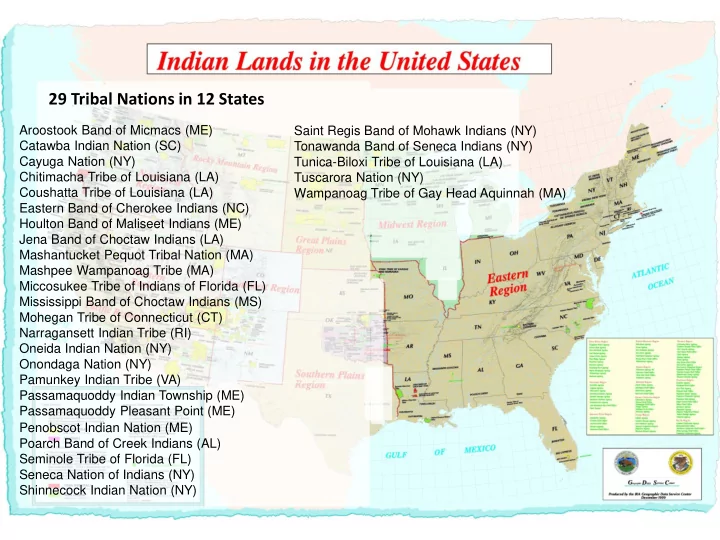

29 Tribal Nations in 12 States Aroostook Band of Micmacs (ME) Saint Regis Band of Mohawk Indians (NY) Catawba Indian Nation (SC) Tonawanda Band of Seneca Indians (NY) Cayuga Nation (NY) Tunica-Biloxi Tribe of Louisiana (LA) Chitimacha Tribe of Louisiana (LA) Tuscarora Nation (NY) Coushatta Tribe of Louisiana (LA) Wampanoag Tribe of Gay Head Aquinnah (MA) Eastern Band of Cherokee Indians (NC) Houlton Band of Maliseet Indians (ME) Jena Band of Choctaw Indians (LA) Mashantucket Pequot Tribal Nation (MA) Mashpee Wampanoag Tribe (MA) Miccosukee Tribe of Indians of Florida (FL) Mississippi Band of Choctaw Indians (MS) Mohegan Tribe of Connecticut (CT) Narragansett Indian Tribe (RI) Oneida Indian Nation (NY) Onondaga Nation (NY) Pamunkey Indian Tribe (VA) Passamaquoddy Indian Township (ME) Passamaquoddy Pleasant Point (ME) Penobscot Indian Nation (ME) Poarch Band of Creek Indians (AL) Seminole Tribe of Florida (FL) Seneca Nation of Indians (NY) Shinnecock Indian Nation (NY)
BIA Eastern Region Budget Testimony FY 2019 S OCIAL S ERVICES American Indian and Alaska Native population living in poverty ~ 28.3%, National poverty rate ~ 15.5% (2011-2015 - US Census Bureau) Social Services unfunded obligation amount $509,600
Social Services Programs suffer due to lack of expertise/staff shortages Fill vacancies critical to performing services Rate of victims and perpetrators constantly increasing Departments must grow to properly serve victims and their abusers Currently, day-to-day emergencies consume current resources Limited time to focus on long-term strategies to combat substandard quality of life and overall dependency on welfare assistance
BIA Eastern Region Budget Testimony FY 2019 S CHOLARSHIPS and A DULT E DUCATION American Indian and Alaska Native high school graduates ~ 79.1%, holding Bachelor’s degree or higher ~ 13.8% -- the rest of the US 86.7% and 33.1%, respectively (2011-2015 - US Census Bureau) Continued education emboldens and inspires to allow for the decrease of problems within the other top 5 priorities while also preparing students (of any age) for the tasks they will face as they enter the workforce
Scholarships and Adult Education Students need support for tuition, as well as supplement expenses not covered by scholarships, grants and other educational funding sources Higher Education and Adult Education is vital in order to access the required educational levels for necessary job skills and training College readiness training assists with barriers that keep Tribal students from college, or from finishing once they start, including lack of knowledge of the college process and homesickness
BIA Eastern Region Budget Testimony FY 2019 I NDIAN C HILD W ELFARE A CT (ICWA) Since the passage of ICWA in 1978, Indian children are still being removed from their homes and communities, more than any other nationality within the United States. Some Tribal Nations have 75% enrolled children placed in non-enrolled/non-American Indian homes (with an approximate 3- year reunification rate with their families)
Indian Child Welfare Act (ICWA) 57% of the Eastern Region Tribal Nations contract the BIA ICWA Program : Average funding = $45,392 Staffing (or understaffing) = Overall successes and failures of ICWA Tribal staff work with some of the most at-risk and needy children in the United States with far fewer resources Additional Funding would mean: More education and Supportive outreach/Prevention services Less unanswered calls More court representation
BIA Eastern Region Budget Testimony FY 2019 T RIBAL C OURTS Tribal Nations must have strong judicial systems to uphold the significant sovereignty and jurisdictional gains made throughout Indian Country [ie: Violence Against Women Act (VAWA) and the implementation of Tribal Law and Order Act (TLOA)]
Tribal Courts Tribal Nations need increased funding to: Comply with recent rulings and legislation [VAWA, TLOA, etc.] Investigations Prosecutions Convictions and sentencing of both Indian and non-Indian perpetrators Provide wide array of protection and services under various laws and provisions Indian Child Welfare Act Child Support Enforcement Temporary Assistance to Needy Families State/Tribal Criminal Codes, etc. Combat high rates of Poverty Substance Abuse Suicide Violent Crime
BIA Eastern Region Budget Testimony FY 2019 A ID TO T RIBAL G OVERNMENTS Over past 5 years, BIA PL 93-638 funding has been cut by over 20% Tribal program activities funded by ATG Economic development Tribal enrollment/census Grants management Planning Tribal constitutions Governing ordinances Infrastructure and Facilities Management Updating Tribal Codes & Enrollment Assisting Grants/Regulatory Division with software, etc.
U.S. Commission on Civil Rights/”A Quiet Crisis: Federal Funding & Unmet Need in Indian Country, 2003”: The Commission finds that significant disparities in federal funding exist between Native Americans and other groups in our nation, as well as the general population. The federal government, through laws, treaties, and policies established over hundreds of years, is obligated to ensure that funding is adequate to meet these needs. Moreover, the government must work diligently to elevate the standard of living among Native Americans to that of other Americans by ensuring that federal agencies create attainable resource-driven goals toward this end. The trust responsibility consists of the highest moral obligations that the United States must meet to ensure the protection of Tribal and individual Indian lands, assets, resources, and treaty and similarly recognized rights (reaffirmed in Sec. Order 3335). Fulfillment of Indian Country funding is a trust and treaty obligation. As such, it should not be viewed as social welfare/addressing unmet needs. It would be most appropriate for the United States to handle its obligations via mandatory federal funding.
Recommend
More recommend